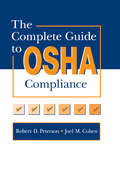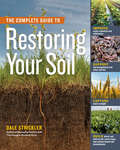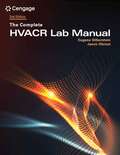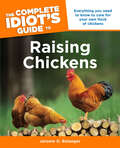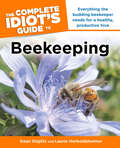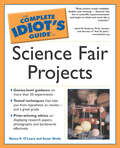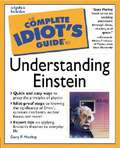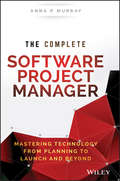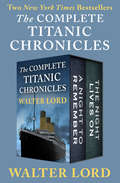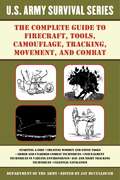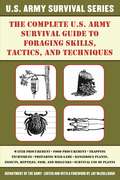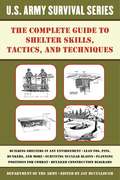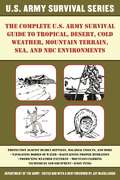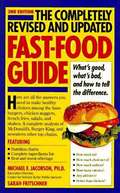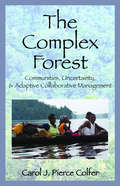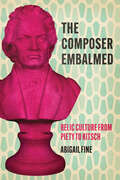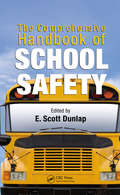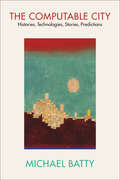- Table View
- List View
The Complete Guide to Drones Extended 2nd Edition: Whatever Your Budget
by Adam JuniperIf you think you need a boarding pass to fly, you're really missing out... Today, drones are everywhere. From film studios to farms, they're in the hands of photographers, commercial surveyors and racers alike. This fully illustrated book explains how drones developed, where they're going and which one you should choose. It even includes complete instructions to build both a simple drone and a super-fast FPV racer yourself.Whether you're flying indoors or out, buying or building, this book covers everything:¿ Understand the Jargon Flying has a lot of unfamiliar terminology, but this book will make it easy to master.¿ Business or Pleasure Every type of multicopter you might want is introduced, including explanations of which is best suited for what role.¿ Get the Best Pictures This edition includes an extended guide to the tech and composition tricks you can use to make your pictures stand out of the pack.¿ Get the Best Video A new shot-guide shows you how to get the most engaging aerial video, whatever your drone.¿ Be a Winning FPV Racer There are two complete step-by-step instructions for building your own drones inside: an FPV racer, or a surprisingly cheap wooden drone - both great projects.Following the worldwide success of the first edition, which has been translated into numerous languages, this second edition is not only fully updated to keep pace with the laws and technology, but also extended to thoroughly cover the fast-growing new sport of FPV drone racing, while still including a comprehensive guide to learning to fly any drone.
The Complete Guide to OSHA Compliance
by Joel M. Cohen Robert D. PetersonThe Complete Guide to OSHA Compliance is an easy-to-understand, one-stop resource designed to help safety professionals, industrial hygienists, and human resources personnel ensure compliance with existing and upcoming OSHA regulations. This essential book explains employer and employee rights and responsibilities, and it provides everything you need to know about employer standards and standards for specific operations. The Complete Guide to OSHA Compliance describes the process of injury/illness recordkeeping and the reporting system required by OSHA. It also explains how to conduct a self-audit to determine whether a company is in full compliance. Furthermore, it informs companies of their rights in an inspection and explains how to handle citations and appeals, should they arise.
The Complete Guide to Restoring Your Soil: Improve Water Retention and Infiltration; Support Microorganisms and Other Soil Life; Capture More Sunlight; and Build Better Soil with No-Till, Cover Crops, and Carbon-Based Soil Amendments
by Dale StricklerHealthy soil is key to sustaining life on Earth. While more and more people are starting to see the need for soil restoration, there is very little understanding of just how it can be accomplished. There is a rapidly emerging demand for a &“how to&” manual for soil restoration. Dale Strickler is an expert on building healthy soil and restoring degraded soil, and in The Complete Guide to Restoring Your Soil, he presents the science of soil, along with proven methods of restoring depleted soil and agricultural practices from around the world that continue to build soil, rather than cause it to deteriorate. Strickler provides a solid foundation in the science of healthy soil, explaining how soil has become so degraded over time and the dire consequences for the human species, not just in terms of food scarcity but also the social, health, and environmental consequences of growing food in poor soil. He addresses the chemical, physical, and biological principles behind soil function, and presents actual farming practices that can be used to regenerate soil, techniques and strategies for remediating contaminated soil, and agriculture systems both past and present that functioned to build soil, such as the ancient chinampas systems of Mexico and the permaculture systems of today.
The Complete Guide to VR & 360 Photography: Make, Enjoy, and Share & Play Virtual Reality
by Jonathan TustainThe Complete Guide to VR will help you get to grips with this exciting new technology from first principles, so you know what's out there, and what you want.Discover all there is to know about home VR systems, whether they're computer-based, or work using your mobile phone. This book will introduce you to a whole spectrum of VR possibilities including VR games, creating your own VR films and exploring the world using it.
The Complete Guide to the Herschel Objects
by Mark BrattonSir William Herschel's contributions to astronomy during the late eighteenth century are unrivalled. His lasting legacy is his dedicated all-sky survey of star clusters and nebulae, and these objects continue to be among the most studied in the night sky. This unique book provides a complete re-examination of Herschel's entire catalogue of non-stellar discoveries, making it the most accurate and up-to-date reference of its kind. Retrace the footsteps of one of history's greatest astronomers and explore every one of Herschel's landmark discoveries, including those considered to be lost or non-existent. Read detailed notes about each object's appearance and physical characteristics, and view hundreds of photos of the most intriguing Herschel objects, along with dozens of sketches of what is visible at the eyepiece. This superb book is a must-have for amateur astronomers seeking new and exciting observing challenges, and as the ultimate reference on the Herschel objects.
The Complete HVACR Lab Manual
by Eugene Silberstein Jason ObrzutThe Complete HVACR Lab Manual is a comprehensive resource that covers the essential knowledge and skills required to be an HVAC technician. Featuring over 250 lab exercises, this lab manual is designed to support the hands-on application and practice needed to confidently approach HVAC/R system issues.
The Complete Idiot's Guide To Raising Chickens: Everything You Need to Know to Care for Your Own Flock of Chickens
by Jerome D. BelangerReaders will flock to this book Raising chickens is a growing trend hitting urban and suburban areas, as well as the country. The Complete Idiot's Guide® to Raising Chickens covers every aspect of raising chickens, whether one lives in the country, suburb, or city. People wanting their own supply of organic, additive-free, free-range eggs want to know how to keep their chickens healthy and egg producing. • How to choose what to start with-chicks, pullets, or hens • How best to feed and water • Coverage of the most popular breeds • Everything about eggs, including how to sell them
The Complete Idiot's Guide to Beekeeping: Everything the Budding Beekeeper Needs for a Healthy, Productive Hive
by Dean Stiglitz Laurie HerboldsheimerThe buzz on beekeeping. The Complete Idiot's Guide® to Beekeeping has all the information a beginning beekeeper needs to know to start a hive and keep it buzzing. Expert beekeepers Dean Stiglitz and Laurie Herboldsheimer, owners of Golden Rule Honey, take readers step by step through the entire process-from information on the inhabitants of a hive and how it works to collecting bees, keeping them healthy, raising a queen, harvesting honey and wax, and storing hives for the off-season.
The Complete Idiot's Guide to Electrical Repair
by Terry MeanyThe Complete Idiot's Guide® to Electrical Repair is a basic instruction manual on home wiring and repair. The book covers AC/DC, volts, watts, fuses, and circuit breakers, national and local codes, and caution signs and safety concerns. Learn when it's best to do–it–yourself and when you need to bring in the pros. Also covered are extension cords and multiple strips, switches and receptacles, installing fixtures and adding new circuits, and working around existing wiring.
The Complete Idiot's Guide to Science Fair Projects: Genius-Level Guidance on More Than 50 Experiments
by Susan Shelly Nancy K. O'LearyIncludes 50 project ideas! Offering one-stop shopping for all readers&’ science fair needs, including 50 projects covering all science disciplines and rated from beginner through advanced, this book takes students and parents through the entire scientific method. The Complete Idiot&’s Guide® to Science Fair Projects offers a variety of experiments with the right chemistry for you! In this Complete Idiot&’s Guide®, you get: • An explanation of the scientific method—and the step-by-step procedure of applying it to your project. • More than 50 projects to choose from in the biological, chemical, botanical, physical, and earth sciences. • Tips on displaying your findings through the creation of graphs, tables, and charts. • An understanding of exactly what the judges look for in a winning project and paper.
The Complete Idiot’s Guide to Understanding Einstein
by Gary MoringThe Complete Idiot's Guide to Understanding Einstein shows how relatively easy--and fun--it can be to learn and appreciate the world of physics and Einstein's brilliant accomplishments.
The Complete Modern Blacksmith
by Alexander WeygersA truly unusual and unique resource, this extremely hands-on book brings together three popular but long-out-of-print classics (THE MODERN BLACKSMITH; THE RECYCLING, USE, AND REPAIR OF TOOLS; and THE MAKING OF TOOLS) essential for anyone interested in the making, repair, maintenance, or arcana of tools. An essential volume in any serious craftperson's library, this book covers setting up a smithy (anvil, forge, hammer, tongs, and all), and manufacturing everything from stone-carving chisels to decorative wall hooks.From the Trade Paperback edition.
The Complete Software Project Manager
by Anna P. MurrayYour answer to the software project management gap The Complete Software Project Manager: From Planning to Launch and Beyond addresses an interesting problem experienced by today's project managers: they are often leading software projects, but have no background in technology. To close this gap in experience and help you improve your software project management skills, this essential text covers key topics, including: how to understand software development and why it is so difficult, how to plan a project, choose technology platforms, and develop project specifications, how to staff a project, how to develop a budget, test software development progress, and troubleshoot problems, and what to do when it all goes wrong. Real-life examples, hints, and management tools help you apply these new ideas, and lists of red flags, danger signals, and things to avoid at all costs assist in keeping your project on track. Companies have, due to the nature of the competitive environment, been somewhat forced to adopt new technologies. Oftentimes, the professionals leading the development of these technologies do not have any experience in the tech field--and this can cause problems. To improve efficiency and effectiveness, this groundbreaking book offers guidance to professionals who need a crash course in software project management. Review the basics of software project management, and dig into the more complicated topics that guide you in developing an effective management approach Avoid common pitfalls by perusing red flags, danger signals, and things to avoid at all costs Leverage practical roadmaps, charts, and step-by-step processes Explore real-world examples to see effective software project management in action The Complete Software Project Manager: From Planning to Launch and Beyond is a fundamental resource for professionals who are leading software projects but do not have a background in technology.
The Complete Titanic Chronicles: A Night to Remember and The Night Lives On (The Titanic Chronicles)
by Walter LordThe complete and definitive New York Times–bestselling chronicle of the Titanic including survivors&’ stories and extensive research separating fact from myth. In just two hours and forty minutes, 1,500 souls were lost at sea when the RMS Titanic succumbed to the icy waters of the North Atlantic. Based on interviews with sixty-three survivors, A Night to Remember tells the story of that fateful night, offering a meticulous and engrossing look at one of the twentieth century&’s most infamous disasters. In The Night Lives On, Lord revisits the unsinkable ship, diving into the multitude of theories—both factual and fanciful—about the Titanic&’s last hours. Was the ship really christened before setting sail on its maiden voyage? How did its wireless operators fail so badly, and why did the nearby Californian, just ten miles away when the Titanic struck the iceberg, not come to the rescue? Together for the first time, Lord&’s classic bestseller A Night to Remember and his subsequent study The Night Lives On offer remarkable insight into the maritime catastrophe that continues to fascinate and horrify a full century later.
The Complete U.S. Army Survival Guide to Firecraft, Tools, Camouflage, Tracking, Movement, and Combat (US Army Survival)
by Army Jay McCulloughIn this vital guide, you’ll find important techniques of wielding firecrafts, constructing tools, creating camouflage, and tracking a prey’s movement. From step-by-step instructions on crafting a flint knife to tips on beating an opponent in close combat, The Complete U.S. Army Survival Guide to Firecraft, Tools, Camouflage, Tracking, and Movement has got you covered. Within these pages you’ll find: Guidelines on selecting the best site to start a fire The most effective moves to use against an opponent in any range of combat How-to chose an optimal location for cover in any terrain Instructions for tracking the movement of dozens of different animals And dozens more critical techniques!With dozens of photographs and illustrations demonstrating techniques and procedures first-hand, this guide is an essential read for every outdoorsman-from the novice weekend camper to the most seasoned survivalist. If you can’t find it within the pages of The Complete U.S. Army Survival Guide to Firecraft, Tools, Camouflage, Tracking, and Movement, then you don’t really need it.
The Complete U.S. Army Survival Guide to Foraging Skills, Tactics, and Techniques
by Jay McCulloughHere in this critical guide is all the important foraging techniques that you’ll need to know in order to survive in just about any situation. From selecting edible berries to trapping small game, The Complete U.S. Army Survival Guide to Foraging Skills, Tactics, and Techniques has got you covered. Within these pages, you’ll find: The proper procedure to construct a water distillery How to discern the difference between poisonous and deadly plants. A step-by-step guide to expertly skinning and cooking a squirrel. And hundreds more critical foraging techniques.With dozens of photographs and illustrations demonstrating these medical techniques and procedures first-hand, this guide is an essential read for every outdoorsman-from the novice weekend camper to the most seasoned survivalist. If you can’t find it in The Complete U.S. Army Survival Guide to Foraging Skills, Tactics, and Techniques, then you don’t really need it.
The Complete U.S. Army Survival Guide to Medical Skills, Tactics, and Techniques (US Army Survival)
by Jay McCulloughHere in this critical guide is all the important medical techniques that you’ll need to know in order to survive in just about any situation. From wrapping life-threatening head wounds to treating a poisonous spider bite, The Complete U.S. Army Survival Guide to Medical Skills, Tactics, and Techniques has got you covered. Within these pages, you’ll find: First-aid techniques for hundreds of different kinds of wounds. Medical procedures necessary for properly treating animal bites and stings. Proper procedures to follow when dealing with toxic environments. And thousands more essential medical tips.With dozens of photographs and illustrations demonstrating these medical techniques and procedures first-hand, this guide is an essential read for every outdoorsman-from the novice weekend camper to the most seasoned survivalist. If you can’t find it in The Complete U.S. Army Survival Guide to Medical Skills, Tactics, and Techniques, then you don’t really need it.
The Complete U.S. Army Survival Guide to Shelter Skills, Tactics, and Techniques (US Army Survival)
by Jay McCulloughHere in this critical guide is all the important safety techniques that you’ll need to know in order to survive in just about any condition. From designing a makeshift earthquake shelter to constructing a water well, The Complete U.S. Army Survival Guide to Shelter Skills, Tactics, and Techniques has got you covered. Within these pages, you’ll find information on the best way to: Choose the best building materials. Select the best ambushing positions in any situation. Construct an underground bunker. And hundreds of more techniques and skillsWith dozens of photographs and illustrations demonstrating these sheltering techniques and procedures first-hand, this guide is an essential read for every outdoorsman-from the novice weekend camper to the most seasoned survivalist. If you can’t find it in The Complete U.S. Army Survival Guide to Shelter Skills, Tactics, and Techniques, then you don’t really need it.
The Complete U.S. Army Survival Guide to Tropical, Desert, Cold Weather, Mountain Terrain, Sea, and NBC Environments
by Army Jay McCulloughWithin this indispensable guide, you’ll find every tip that you’ll ever need to thrive in any type of landscape, in any degree of climate. From managing the heat of the tropics to combatting the chill of the mountaintops, The Complete U.S. Army Survival Guide to Desert, Forest, Jungle, Plain, Mountain, and Urban Environment has got you covered. Within these pages you’ll discover such vital tips as: How-to treat hypothermia The correct method of righting a capsized craft Tips for minimizing the dire effects of chemical exposure And dozens more crucial survival tips!With dozens of photographs and illustrations demonstrating these procedures and techniques first-hand, this guide is an essential read for every outdoorsman-from the novice weekend camper to the most seasoned survivalist. If you can’t find it in The Complete U.S. Army Survival Guide to Desert, Forest, Jungle, Plain, Mountain, and Urban Environment then you don’t really need it.
The Completely Revised and Updated Fast-Food Guide
by Michael F. Jacobson Sarah FritschnerCompletely revised and updated, this guide is a must for people who care about their kids, their waistlines, and their arteries.
The Complex Forest: Communities, Uncertainty, and Adaptive Collaborative Management
by Carol J. Pierce ColferThe Complex Forest systematically examines the theory, processes, and early outcomes of a research and management approach called adaptive collaborative management (ACM). An alternative to positivist approaches to development and conservation that assume predictability in forest management, ACM acknowledges the complexity and unpredictability inherent in any forest community and the importance of developing solutions together with the forest peoples whose lives will be most affected by the outcomes. Building on earlier work that established the importance of flexible, collaborative approaches to sustainable forest management, The Complex Forest describes the work of ACM practitioners facing a broad range of challenges in diverse settings and attempts to identify the conditions under which ACM is most effective. Case studies of ACM in 33 forest sites in 11 countries together with Colfer's systematic comparison of results at each site indicate that human and institutional capabilities have been strengthened. In Zimbabwe, for example, the number of women involved in decisionmaking soared. In Nepal, community members detected and sanctioned dishonest community elites. In Cameroon and Bolivia, learning programs resulted in better conflict management. These are early results, but a wide range of recent research supports Colfer's belief that these new capabilities will eventually contribute to higher incomes and to sustainable improvements in the health of forests and forest peoples. The Complex Forest reinforces calls for change in the way we plan conservation and development programs, away from command-and-control approaches, toward ones that require bureaucratic flexibility and responsiveness, as well as greater local participation in setting priorities and problem solving.
The Composer Embalmed: Relic Culture from Piety to Kitsch (New Material Histories of Music)
by Abigail FineThe first granular study of nineteenth-century composer devotion—a network of devotees who preserved tangible traces of composers through relics, rituals, pilgrimage, exhumation, and embalming. During the nineteenth century, music institutions promoted artworks they deemed timeless and made composers into figureheads of a lasting Western canon. Alongside this institutional face of the canon was a more intimate impulse to preserve, touch, and embrace the residues of the dead. In Germany and Austria between 1870 and 1930, music lovers venerated the bodies, houses, and belongings of composers as relics, shrines, and talismans. In The Composer Embalmed, Abigail Fine documents the vernacular and eccentric ways that composers have been remembered. Fine navigates a wealth of unknown archival material to recover the stories of devotees: from pilgrims who felt time stop in historic houses to music-loving doctors who made skulls into sacred specimens, dilettantes who displayed Beethoven’s mask as a relic of the “beautiful death,” and interwar critics of those dilettantes who disparaged piety as a false religion, a kitsch replica. In isolation, these practices may look like simple acts of affection. But in the aggregate, Fine asserts, acts of devotion constituted what we might broadly understand as relic culture—a culture that sought to possess the body of the departed genius, and that superimposed habits of anthropological collecting onto artifacts of Austro-German heritage. By excavating objects, ephemera, amateur lyric, visitors’ books, letters, and travelogues, The Composer Embalmed reveals the underbelly of the canon, where guilty pleasures blur the boundary between sanctity and desecration.
The Comprehensive Handbook of School Safety (Occupational Safety & Health Guide Series)
by E. Scott DunlapIn most schools you will probably see one, if not all of the following:Metal detectors to prevent handguns and other weapons from being brought onto school propertyStudents in standardized uniforms to prevent the appearance of gang affiliationsPolice officers patrolling the property to deter violent activity as well as respond to incidentsSuch evol
The Computable City: Histories, Technologies, Stories, Predictions
by Michael BattyHow computers simulate cities and how they are also being embedded in cities, changing our behavior and the way in which cities evolve.At every stage in the history of computers and communications, it is safe to say we have been unable to predict what happens next. When computers first appeared nearly seventy-five years ago, primitive computer models were used to help understand and plan cities, but as computers became faster, smaller, more powerful, and ever more ubiquitous, cities themselves began to embrace them. As a result, the smart city emerged. In The Computable City, Michael Batty investigates the circularity of this peculiar evolution: how computers and communications changed the very nature of our city models, which, in turn, are used to simulate systems composed of those same computers.Batty first charts the origins of computers and examines how our computational urban models have developed and how they have been enriched by computer graphics. He then explores the sequence of digital revolutions and how they are converging, focusing on continual changes in new technologies, as well as the twenty-first-century surge in social media, platform economies, and the planning of the smart city. He concludes by revisiting the digital transformation as it continues to confound us, with the understanding that the city, now a high-frequency twenty-four-hour version of itself, changes our understanding of what is possible.

